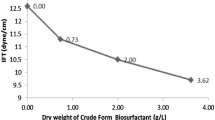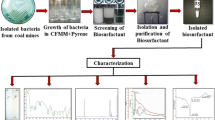Abstract
Biosurfactant-producing bacteria were isolated from various sources in the south of Thailand. Isolates were screened for biosurfactant production using jackfruit seed powder (JSP) as a novel and promising substrate. The highest biosurfactant activity was obtained with a bacterial strain which was identified by 16S rRNA gene sequence analysis as Deinococcus caeni PO5. D. caeni PO5 was able to grow and reduce the surface tension of the culture supernatant from 67.0 to 25.0 mN/m after 87 h of cultivation when 40 g/l of JSP and 1 g/l of commercial monosodium glutamate were used as carbon and nitrogen sources, respectively. The biosurfactant obtained by ethyl acetate extraction showed high surface tension reduction (47.0 mN/m), a small critical micelle concentration value (8 mg/l), thermal and pH stability with respect to surface tension reduction and emulsification activity, and a high level of salt tolerance. Chemical characterization by biochemical testing, Fourier transform infrared spectroscopy, and mass spectra revealed that the obtained biosurfactant was a glycolipid-type biosurfactant. The obtained biosurfactant was capable of forming stable emulsions with various hydrocarbons and had the ability to enhance oil recovery, the solubility of polyaromatic hydrocarbons, heavy metal removal, and antimicrobial activity.





Similar content being viewed by others
References
Abdel-Mawgoud AM, Lepine F, Deziel E (2010) Rhamnolipids: Diversity of structures, microbial origins and roles. Appl Microbiol Biotechnol 86:1323–1336
Babitha S, Soccol CR, Pandey S (2006) Jackfruit seed for production of monascus pigments. Food Technol Biotechnol 44:465–471
Batista SB, Mounteer AH, Amorim FR, Totola MR (2006) Isolation and characterization of biosurfactant/bioemulsifier producing bacteria from petroleum contaminated sites. Bioresource Technol 97:868–875
Cameotra SS, Singh P (2008) Bioremediation of oil sludge using crude biosurfactants. Int Biodeter Biodegr 62:274–280
Chooklin CC, Phertmean S, Cheirsilp B, Maneerat S, Saimmai A (2013) Utilization of palm oil mill effluent as a novel substrate for biosurfactant production by Nevskia ramosa NA3. Songklanakarin J Sci Technol 35:167–176
Desai JD, Banat IM (1997) Microbial production of surfactants and their commercial potential. Microbiol Mol Biol Rev 61:47–64
Dubois M, Gilles KA, Hamilton JK, Rebers PA, Smith F (1956) Colorimetric method for determination of sugars and related substances. Anal Chem 28:350–356
Folch JM, Lees M, Stanly HS (1956) A simple method for the isolation and quantification of total lipids from animal tissues. J Biol Chem 226:497–509
Franzetti A, Tamburini E, Banat IM (2012) Applications of biological surface active compounds in remediation technologies. Adv Exp Med Biol 672:121–134
Gudina EJ, Teixeira JA, Rodrigues LR (2010) Isolation and functional characterization of a biosurfactant produced by Lactobacillus paracasei. Colloid Surf B 76:298–304
Janek T, Lukaszewicz M, Rezanka T, Krasowska A (2010) Isolation and characterization of two new lipopeptide biosurfactants produced by Pseudomonas fluorescens BD5 isolated from water from the arctic archipelago of Svalbard. Bioresource Technol 101:6118–6123
Kuda T, Kyoi D, Takahashi H, Obama K, Kimura B (2011) Detection and isolation of p-nitrophenol-lowering bacteria from intestine of marine fishes caught in Japanese waters. Marine Pollut Bull 62:1622–1627
Lowry OH, Rosebrough NJ, Farr AL, Randall RJ (1951) Protein measurement with the Folin phenol reagent. J Biol Chem 193:265–275
Monteiroa AS, Mirandaa TT, Lulab I, Denadaic AML, Sinisterra RD, Santoroe MM, Santosa VL (2011) Inhibition of Candida albicans CC biofilms formation in polystyrene plate surfaces by biosurfactant produced by Trichosporon montevideense CLOA72. Colloid Surface B 84:467–476
Morton J (1987) Jackfruit. In: Morton JF (ed) Fruits of warm climates. Florida Flair Books, Miami, pp 58–64
Mulligan CN (2005) Environmental applications for biosurfactants. Environ Pollut 133:183–198
Mulligan CN, Yong CN, Gibbs BF (2001) Heavy metal removal from sediments by biosurfactants. J Haz Mat 85:111–125
Muthusamy K, Gopalakrishnan S, Ravi TK, Sivachidambaram P (2008) Biosurfactants: Properties, commercial production and application. Curr Microbiol 94:736–747
Obayori O, Ilori M, Adebusoye S, Oyetibo G, Omotayo A, Amund O (2009) Degradation of hydrocarbons and biosurfactant production by Pseudomonas sp. strain LP1. World J Microbiol Biotechnol 25:1615–1623
Plaza GA, Zjawiony I, Banat IM (2006) Use of different methods for detection of thermophilic biosurfactant-producing bacteria from hydrocarbon contaminated and bioremediated soils. J Pet Sci Eng 50:71–77
Pornsunthorntawee O, Arttaweeporn N, Paisanjit S, Somboonthanate P, Abe M, Rujiravanit R, Chavadej S (2008) Isolation and comparison of biosurfactants produced by Bacillus subtilis PT2 and Pseudomonas aeruginosa SP4 for microbial surfactant-enhanced oil recovery. Biochem Eng J 42:172–179
Ruggeri C, Franzetti A, Bestetti G, Caredda P, La Colla P, Pintus M, Sergi S, Tamburini E (2009) Isolation and characterization of surface active compound-producing bacteria from hydrocarbon-contaminated environments. Int Biodeter Biodegr 63:936–942
Saimmai A, Kaewrueng J, Maneerat S (2012a) Used lubricating oil degradation and biosurfactant production by SC-9 consortia obtained from oil contaminated soil. Ann Microbiol 62:1757–1767
Saimmai A, Rukadee O, Onlamool T, Sobhon V, Maneerat S (2012b) Characterization and phylogenetic analysis of microbial surface active compounds-producing bacteria. Appl Biochem Biotechnol 168:1003–1018
Saimmai A, Rukadee O, Onlamool T, Sobhon V, Maneerat S (2012c) Isolation and functional characterization of a biosurfactant produced by a new and promising strain of Oleomonas sagaranensis AT18. World J Microbiol Biotechnol 28:2973–2986
Saimmai A, Rukadee O, Onlamool T, Sobhon V, Maneerat S (2013a) An efficient biosurfactant-producing bacterium Selenomonas ruminantium CT2, isolated from mangrove sediment in south of Thailand. World J Microbiol Biotechnol 29:87–102
Saimmai A, Rukadee O, Onlamool T, Sobhon V, Maneerat S (2013b) Production and characterization of biosurfactant from marine bacterium of Inquilinus limosus KB3 grown on low-cost raw materials. Ann Microbiol 29(1):87–102
Seydlova G, Svobodova J (2008) Review of surfactin chemical properties and the potential biomedical applications. Cent Eur J Med 3:123–133
Suwansukho P, Rukachisirikul V, Kawai F, Kittikun AH (2008) Production and applications of biosurfactant from Bacillus subtilis MUV4. Songklanakarin J Sci Technol 30:87–93
Thavasi R, Jayalakshmi S, Balasubramanian T, Banat IM (2007) Biosurfactant production by Corynebacterium kutscheri from waste motor lubricant oil and peanut oil cake. Lett Appl Microbiol 45:686–691
Thavasi R, Jayalakshmi S, Balasubramaniam T, Banat IM (2008) Production and characterization of a glycolipid biosurfactant from Bacillus megaterium using economically cheaper sources. World J Microbiol Biotechnol 24:917–925
Urum K, Pekdemir T (2004) Evaluation of biosurfactants for crude oil contaminated soil washing. Chemosphere 57:1139–1150
Vatsa P, Sanchez L, Clement C, Baillieul F, Dorey S (2010) Rhamnolipid biosurfac-tants as new players in animal and plant defense against microbes. Int J Mol Sci 11:5095–5108
Youssef NH, Dunacn KE, Nagle DP, Savage KN, Knapp RM, McInerney MJ (2004) Comparison of methods to detect biosurfactant production by diverse microorganism. J Microbiol Methods 56:339–347
Acknowledgments
We are grateful to Phuket Rajabhat University for providing a scholarship to Saimmai A. This work was supported by the Higher Education Research Promotion and National Research University Project of Thailand, Office of the Higher Education Commission and International Foundation for Science (Sweden) No. F/5204-1.
Author information
Authors and Affiliations
Corresponding author
Rights and permissions
About this article
Cite this article
Chooklin, C.S., Petmeaun, S., Maneerat, S. et al. Isolation and characterization of a biosurfactant from Deinococcus caeni PO5 using jackfruit seed powder as a substrate. Ann Microbiol 64, 1007–1020 (2014). https://doi.org/10.1007/s13213-013-0738-2
Received:
Accepted:
Published:
Issue Date:
DOI: https://doi.org/10.1007/s13213-013-0738-2




